June 2016
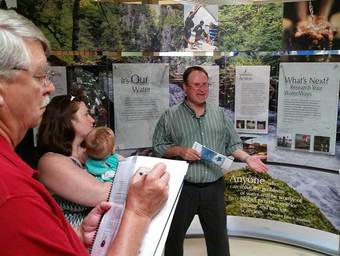 The grand opening of the Smithsonian Water/Ways exhibit is set for 10 a.m., Saturday, June 25 at Prairie Woods Environmental Learning Center west of Spicer. Everyone is invited to the opening, or to visit the exhibit through Aug. 7. Grand opening schedule:
- 9:30-10 a.m.: Guests arrive at Prairie Woods Environmental Learning Center.
- 10 a.m.: Remarks from David O'Fallon (Minnesota Humanities Center), Dave Pederson (Prairie Woods ELC), and following assistant commissioners: Rebecca Flood (MPCA), Barb Naramore (DNR), and Paul Allwood (MDH). Ribbon cutting and cake to follow.
- Water/Ways exhibit open to the public until 5 p.m.
Water/Ways is a traveling exhibition from the Smithsonian's Museum on Main Street program. The exhibit reveals the central nature of water in our lives by exploring how Americans use water, how water unites communities, how water affects every element of life, and how Americans care for our water and protect this valuable resource. Photo: Robbie Davis (right) of the Smithsonian Institution Traveling Exhibit Service leads the installation workshop Wednesday; taking notes, Les Feyma; Jennifer Tonko of the Minnesota Humanities Center holds 5-month-old Tilia.
Upcoming Water/Ways schedule:
Aug. 13-Sept. 25: St. Peter, Nicollet County Historical Society.
Oct. 1-Nov. 13: Red Wing, Goodhue County Historical Society.
Nov. 19-Jan. 1, 2017: Sandstone (Pine County), Audubon Center of the North Woods.
Jan. 7-Feb. 19, 2017: Lanesboro (Fillmore County), Lanesboro Arts.
Feb. 25-April 9, 2017: Detroit Lakes (Becker County), Becker County Historical Society.
Back to top
|
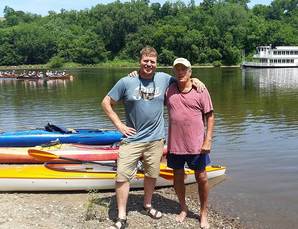 About 200 paddlers braved the steamy weather June 11, and collectively paddled all 318 miles of the Minnesota River. During the 'Paddle the Minnesota River in a Day' event, "we proved that the Minnesota River is a recreational treasure that connects so many Minnesotans," says Alex Watson of the DNR. "I believe there was a human on every river mile of the Minnesota River on June 11, 2016! I hope we can continue and build off our collective efforts, taking a day to celebrate the river by getting wet and muddy in its waters, and just maybe paddle a river in a day."
Mike Stout claimed the longest paddle, a 47.3-mile segment
in ten hours. “While
it was not a goal of mine at the beginning of the season, it is now my goal to
complete paddling the entire Minnesota River,” Mike said. Paul Tinklenburg paddled the most difficult river section. Starting at the headwaters at Ortonville where BIg Stone Lake empties into the Minnesota, it meanders to the Big Stone National Wildlife Refuge. The route had little water but teemed with wildlife.
Caroline Black (Morton to Franklin), said, “Thank you for the wonderful inspiration to kayak the Minnesota River
today. We accessed the river just west of Morton and kayaked the
nearly 11 miles to Franklin. The trip took 3-1/2 hours and we loved it. I presented my fellow paddlers, Lee Ann Ristow, Naomi Evenson and Wendy
Ristow with the Minnesota River Trail stickers, which they immediately put on their
kayaks." DNR photo: Erik Wrede
(left), DNR water trails coordinator; and John Helland, Minnesota Center for Environmental Advocacy board member.
Back to top
|
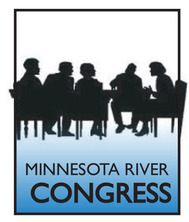 One of the first tasks of the newly-created Minnesota River
Congress will be to survey all the various policies among scores of groups that
relate to the river basin, and glean a small list to adopt and support.
Meeting May 16 in Henderson, the Congress Action Board
discussed a plan to solicit existing policy ideas from organizations in the
basin. After initial contacts, several meetings will be scheduled around the
basin to gather policy ideas. They will be the focus of the next full Congress
meeting in November. Existing public policies by organizations who wish to have a policy considered by the Minnesota River Congress can be submitted to the Public Policy Team Liaison Ted Suss.
“This will be a dynamic process,” says Ted Suss, a member of
the Congress Action Board management team. “We hope to glean these from all
groups, and narrow down to four or five good ones for the Congress. The
policies can be statewide, but they must also relate to the Minnesota River
basin.”
In other business May 16, the Action Board approved by-laws
and new memberships, confirmed the management team, and reviewed changes to the
list of specific interest teams.
Among other agenda items, a consensus of the Action Board
supported: The governor’s effort to create a ‘water ethic’, including
spirituality in the interest group missions, and proposed legislation to fund a
study of common interests and goals in the Minnesota River basin.
Back to top
|
Applications are open for Watershed Specialist training offered this fall by the U of M Water Resources Center. The training is designed to help local
conservation professionals strengthen their ability to protect water resources.
Participants are staff from SWCDs, watershed districts, tribes, counties, and cities, along
with state agency staff and private consultants.
Lessons cover fundamentals and provide practical skills, including activities such as assessing the community and stakeholders, designing monitoring or
evaluation programs, writing a communication strategy, comparing and selecting
implementation activities, writing work plans, and much more. Participants
leave the course with more confidence to do their job, a boost to their career,
and connections to colleagues around the state working with Watershed Restoration and Protection Strategies, stormwater
plans, and other water restoration and protection efforts, large and small.
WST is delivered entirely online. The fall session runs Sept. 6 through
Dec. 11, 2016. Apply by July 15 to reserve your space. Learn
more and apply at wst.umn.edu. Or contact Ann
Lewandowski, alewand@umn.edu,
612-624-6765.
Back to top
 Agricultural drainage and water quality is the focus of the summer tour July 8 of the Minnesota Association of Professional Soil Scientists. The tour will visit a Discovery Farm project (Simonsen Farm) near Fairfax in Renville County, and include presentations on soil properties and tile drainage design, Minnesota River water quality, and geomorphology. Registration information is available online at: www.mnsoilscientist.org/2016-summer-tour. The fee (add $10 after June 30) is $50 for MAPSS members, $60 for non-members, and $20 for students. MAPSS was founded in the early 1970s to have organization by which soil scientists could be certified and be recognized by other professionals such as engineers, etc.
Back to top
|
An online calendar of events
related to agricultural drainage was recently launched at the University of
Minnesota. Access it at z.umn.edu/DrainageEvents
to find information about workshops, field days, webinars and other events
across Minnesota. A form is available at the site where any user can submit
details about events to be added to the calendar. More information about ag drainage is available online provided by the U of M Extension drainage team.
Back to top
Soils with excess phosphorus, that is, phosphorus (P) levels
much higher than are required for good crop growth, have a higher risk of loss
to surface waters than those with soil test levels in the crop recommended
ranges. This situation is most prevalent where the farm net imports of P exceed
exports over several years and P accumulates in the soil.
Livestock farms that
are land-limited relative to the amount of manure and fertilizer P applied have
some options for reducing their P import-export imbalances as outlined in nine
Minnesota case studies available in the Manure Application section of the
University of Minnesota Extension Manure Management and Air Quality website,
z.umn.edu/manure. These strategies were presented in workshops, field days, and
presentations across Minnesota in 2015 and 2016, and are available for use by
watershed and conservation staff working with livestock producers.
Case studies addressing grid soil sampling for guiding
manure application, others for economic valuation of manure nutrients for
optimal application rates, as well as other resources, are available for use by
livestock producers, agricultural professionals, and agency staff at the same
website.
Back to top
The Land Stewardship Program has just released a tool for farmers to calculate the financial pluses and minuses of
integrating cover crops, perennial pasture grasses and other forms of
continuous living cover into their operations. When
thinking about switching to a different farming system, one of the first
questions many farmers want answered is: "How will this work
financially?"
The Chippewa 10% Project developed the Cropping Systems
Calculator to help answer this question by allowing farmers to plug in various
planting and grazing scenarios and weigh the financial pros and cons of each
option. This
easy-to-use Excel-based tool allows farmers to compare
two crop rotations, each up to six years in length, and provides average yearly
returns as well as a year-by-year breakdown. The calculator takes into account
the crop-specific costs for many popular crops, but also the overhead costs of
the entire farm operation. Website. Blog post.
Back to top
 The University of
Minnesota is presenting a one-day symposium Sept. 16 to explore the current
science behind the design, effectiveness, and implementation of riparian
buffers. The target audience is University researchers and students, state and
federal agency staff, and private sector engineers, agricultural advisors, and
conservationists who influence buffer implementation and policy. The symposium,
in the Northstar Ballroom, University of Minnesota, St. Paul Campus, will provide
a scientific foundation to inform future training, rules, implementation
projects, and research.
Confirmed speakers: Tom Isenhart, Iowa State University; Gary Bentrup, National
Agroforestry Center; James Stark, US Geological Survey; and researchers and
buffer specialists from across the University of Minnesota and state agencies.
On Saturday, Sept. 17, the Department of Bioproducts and Biosystems Engineering
and the Society for
Ecological Restoration-Midwest Great Lakes Chapter will lead a field trip
to look at stream restoration, buffers and riparian management projects in the
area.
Go to www.wrc.umn.edu/bufferdesignsym
for more about the agenda, registration, and to submit a poster abstract. Photo: CRP buffer along South Fork Crow River.
Back to top
|
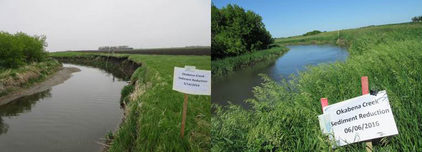 The Heron Lake Watershed District (HLWD) works with landowners to
install projects that help stabilize streambanks to reduce the amount of
sediment entering the water. In 2012, the HLWD received a 319 grant to increase landowner awareness of J-hook weirs, unique streambank
stabilization structures, through the installation of one site on Jack Creek
and two sites on Okabena Creek.
Stream changes at these sites
have been documented over the three-year grant period through photos and video
footage. Transparency tube readings are also taken to record water clarity at
the sites. Final results will be compiled and published in a final report at the
end of August 2016.
Follow project progress on
the HLWD website at www.hlwdonline.org/php. For more information contact Jan Voit at jan.voit@mysmbs.com
or Catherine Sereg at catherine.wegehaupt@noblesswcd.org. Photo: Left: Okabena Creek before the J-hook weirs were installed in the summer of 2014 in Section 7 of West Heron Lake Township in Jackson County. Right: June 6, 2016.
Back to top
|
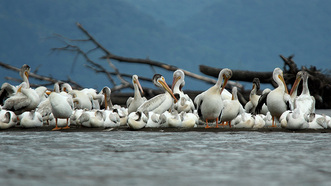 More than 70 residents of Lake Pepin communities recently shared
their personal connection to the lake at a community meeting held by the Lake
Pepin Legacy Alliance at the St. James Hotel April 14. Fishermen, artists, hunters, birders,
business leaders, tour guides and boaters attended. Many expressed concerns
related to the changing habitat, ecosystems and depths as well as the lake’s
turbid conditions due to increased and suspended sediment.
Longtime resident, Suzanne Blue, described her favorite moments
with family kayaking outings. She
expressed concern about the lake filling in and less access to favorite nooks
and backwaters. As a new birdwatcher,
Blue described her joy at discovering so many birds that have been longtime
residents and many other migratory species.
“Those birds rely on resting and finding food in the habitat of
the Mississippi River and in Lake Pepin while migrating this flyway every year,”
said Tim Schlagenhaft of Audubon Minnesota.
Audubon Minnesota is partnering with LPLA on a proposed habitat
and water quality restoration project near the head and backwater bay areas
through the beneficial use of dredging. Moving
sediment and placing it strategically to build islands can create areas of
better habitat and water conditions.
“The restoration project is officially being considered by the
Army Corps of Engineers in an initial inquiry stage. We’ll know if it’s
approved for a federal feasibility study in several months,” said Rylee Main,
Executive Director of Lake Pepin Legacy Alliance. Photo: Pelicans on Lake Pepin by David Meixner.
Back to top
|
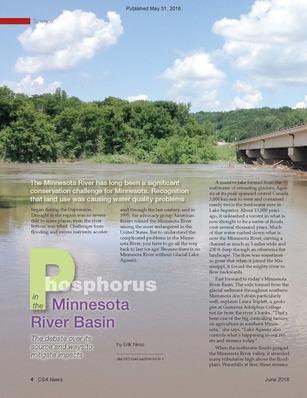 The June 2016 issue of CSA News features an objective overview of the phosphorus-sediment debate and research in the Minnesota River basin. The
article by Erik Ness shows "the discussions surrounding the research
and perspective of Schottler, Gupta, Wilcox, Belmont, etal regarding
phosphorus/sediment in our surface waters. ... we all continue to look for ways
forward in dealing with the problems of phosphorus and sediment in Minnesota,"
says Tim Gillette, Conservation Drainage Engineer, BWSR. The disagreement occurs in two basic perspectives: The leading cause of increased sediment and phosphorus is due either to increased precipitation, or increased artificial drainage.
The article concludes with reference to Patrick Belmont's interest in controlling flow: "The good news for farmers is that he doesn't think removing tile is the right solution. It's not economically feasible and will ultimately just shift the sediment source back to agricultural lands. (Slowing the flow) means installing wetland and detention basins... it won't be cheap but can be done in ways that not only reduce sediment, but also provide other benefits such as nitrogen reduction. Another option would be to increase soil organic matter."
CSA News is the official magazine for members of the American Society of Agronomy, Crop Science Society of America, and Soil Science Society of America.
Back to top
|
|